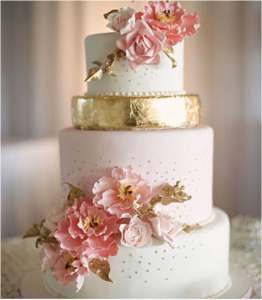By Melissa Charlton, WPICC of EventLux
I entered the wedding industry as a wedding cake maker, and I would always get asked, “Why do custom wedding cakes cost so much??” It was so frequent, that I actually had a pre-written paragraph I would copy and paste into emails when I got asked. I ended up taking an early “retirement” from cakes, as the market would just not support the prices I would have to charge.
It all starts with the word “custom. To put it in “Planner perspective”, what do you think when you hear “CUSTOM made wedding gown”? Or “CUSTOM made table linens? Custom made anything costs more money, and cakes are no different. Each client who orders a cake for a wedding has a vision of how it will look. Each and every cake is unique.
I remember a certain client. She wanted a five-tier, fondant covered cake, fondant roses, to serve 350, and delivered an hour away during the scorching summer. Her budget was $400. It was a good thing it was an email inquiry-a good mouthful of a pumpkin spiced latte was lost over that one! We talked, and after educating her about pricing, she cut the servings down to about 240, as many guests do not want to eat the cake.
Let’s talk about the process of a wedding cake, I would typically start on the Sunday prior to the wedding (assuming it was on a Saturday):
Sunday: Confirm with client. Specify time, place, design, etc. I would generally ask if they wanted any MINOR last-minute changes. *Most bakeries will NOT allow this so close to delivery date*. I then would look over all conversations and emails to ensure no details are missed. Start prepping decorations (we will use roses as an example).
Time: 3 hours, depending how much you need to prep the decorations.
Monday: Time to bake! Let’s use our “five-tiered, $400” cake for example. I would do a 5” tall layer if not specified. Shorter layers looked less exquisite to me. Each tier has 3 layers. That’s 15 pans of cake! When you use a heavy mixture of butter, oils, etc, it takes a LONG time to bake. Roughly an hour for each set of pans that would fit in my oven. Take out of pan while still warm and wrap. Refrigerate for a day.
Time: 7 hours. You actually stay quite busy in between washing dishes, prepping the next batch of batter.
Tuesday: Fill the cake. This includes levelling (cutting the “dome” off the top of the cake, filling, and stacking each tier. We then use a thinner consistency buttercream to seal the exposed cake. We do not want it to dry out. All three layers on each tier must be STRAIGHT. The buttercream will stiffen up in the fridge and cement the layers together. Assemble on a cake circle (cardboard covered in water resistant coating, or foil). Refrigerate overnight. After you are done filling, work on your roses some more until finished. Each rose, depending on the intricacy, can take 10-30 minutes to assemble. Let dry
Time: 2.5 hours to fill, 6 hours for prep. 8.5 Hours
Wednesday: Time to “dirty ice” as Cake Boss would say. This is the layer of icing under the fondant. The “real” icing that guests will peel that expensive fondant off for. In order to have perfect fondant, you must have a perfect layer of buttercream. No dents, no holes, no uneven leveling, exactly 90° walls. Ice, refrigerate until firm. Take out. Patch imperfections. Refrigerate until firm. Check again…patch, refrigerate. Done. Now for layers 2, 3, 4, and 5.
Time: I like to average about an hour per layer. Smaller ones less, but bigger ones much more. 5 hours.
Thursday: Yay! Finally time for fondant. First we get the fondant warm. It is quite stiff when it has been stored. It helps to put it near your warm stove for an hour before you start with it. You will now need to add a thin layer of icing to the “dirty iced” cake, so that the fondant will stick. I just used a wide pastry brush. Quickly roll out the fondant, evenly. Thinner is better, but not too thin, you will see cake! Not too thick. A great way to add more people to the “fondant-haters brigade”. Roll the fondant up on your rolling pin, and unroll over cake. Smooth out, being careful to get no wrinkles. Refrigerate for an hour. Define the edges with a smoother. Put back into refrigerator.
Time: 3 hours. About 30 minutes per cake.
Friday: Time to stack the cake. This is incredible tedious. A small difference in height on the bottom tier, creates a big tilt on the top tier. Cut all support dowels very carefully. Be sure to insert longer dowels through multiple tiers as your cake gets taller for support.
By now, you will likely have a bride who wants a photo. Be prepared for text messages. I call this “Cake-Wreckphobia”.
Once stacked, likely in two pieces as cakes are HEAVY, put back in the fridge. You will assemble and add roses at the venue. If you are super ahead of the game, you will pack up roses, and determine the route. Check the weather. Be sure you have packed every tool you may need to fix the cake in case of disaster.
Time: Two hours to stack. One hour to prep for delivery. 3 hours.
Saturday: Your delivery time should suit the time of the reception. You need to slowly temper the cake to avoid it from “sweating”. I like to remove it from the fridge two hours prior to event. Usually just before I leave to deliver. Have your A/C turned on in your car to continue tempering the cake.
Once you reach the venue, find a cart. Wheel it in. Stack, and add roses.
Don’t forget to take a picture!
Time: One hour to pack up, one hour drive, one hour to assemble and decorate. 3 hours.
So we are at 33 hours, five tiers, and 245 servings. Even if you paid your cake artist $15 an hour, that is still $495.
| Item | Cost |
| Labor | $495 |
| Supplies, at 30% (minimum) | $148.50 |
| Delivery | $50 |
| Total | $593.50 |
A typical cake baker will mark up that cake 100% to cover overhead, so we have a grand total of $1187, or $4.88 per serving, plus GST (or HST), and tip.
Your cake maker is not just selling flour, eggs, and butter. They are also selling the design, talent and overhead. Do your cake maker a favor, and do not let your client lowball them. They have worked hard to give your client a piece of custom, one-of-a-kind, delicious, edible art.
Signs of a great cake:
1. It is even. You don’t notice it leaning
2. The edges are clean and sharp. Super rounded edges indicate VERY thick fondant, usually due to inexperience. Thick fondant = smoother appearance. This is where the “perfect buttercream” or “dirty-icing” comes into play. Perfect buttercream = thinner fondant.
3. Fondant is not cracked, or greasy looking. Inexperienced bakers tend to use icing sugar, or too much shortening to roll out their fondant.
4. There is a very small piped border around the edge of each tier. This shows that they are not trying to hide any wrinkles in the fondant, which usually appear around the base of the tier. A thick ribbon around the base is not a good indicator, unless obviously part of the design.
5. Smooth side of the cake. You cannot see a bulge where the icing is getting pushed out between the layers
Melissa’s involvement in the event industry started as a vendor for wedding cakes. As time passed, she found herself wanting to do more. Hence Eventlux Design & Management was born. Her passion is to flip a non-conventional venue space into something magnificent with décor and the magic of lighting. In her free time, she enjoys being outside with her kids, crafting, and travelling.ng In her free time, she enjoys being outside with her kids, crafting, and travelling.








Great article! Gives great insight on the process of designing and making gorgeous wedding cakes.
Appreciate custom design! 🙂